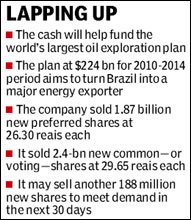Bond yields rose to highest level in more than a week, nudging 8%, following the central bank’s move on Thursday to raise the repo and reverse repo rate. The ten-year benchmark bond, carrying a coupon of 7.80% and maturing in 2020, rose by about 5 basis points to touch 7.99%, the highest level since September 6, 2010. At the same time, the yield on the five-year government paper touched a near two-year high of 7.77%. Treasurers expect yields to move in a narrow range. ?The 10-year bonds should trade in the range of 7.90-8.10% in the near term,? says Phani Shankar, head, (financial markets) at Ing Vysya Bank. Moses Harding, head (global markets), Indusind Bank, says he expects the 10-year to trade at 7.90-8% levels.
Shankar observes, ?It was a hawkish policy. The market was expecting a 25 bps rise in both the repo and reverse repo rate. While the bond markets have not reacted much to the policy, it will continue to be driven by other short term factors like the government debt supplies and the liquidity scenario.?
Harding explains, ?RBI’s intention is to maintain the shorter end yield curve at elevated levels in the event of a shift of the operating rate from repo to the reverse repo. The signals are clear that tight controls will be exercised till a clear turnaround is seen in the inflationary trend ? till food and fuel price inflation fall below 10% and the wholesale price index below 7%. Given the current domestic and external scenario, the stance is welcome as higher borrowing cost may not have significant impact on the economy.?
 According to Joydeep Sen, senior vice-president (advisory), BNP Paribas Wealth Management, ?The 10-year benchmark gilt is near 8% now but has not crossed 8% even after the rate hikes, which means the market has already discounted milder rate hikes going forward. While this is not to say that 8% is the cap, on a bad day, when sentiments are on a downbeat, it may touch 8.25%. However, I think it will trade in a range of 7.75-8% for the time being.?
According to Joydeep Sen, senior vice-president (advisory), BNP Paribas Wealth Management, ?The 10-year benchmark gilt is near 8% now but has not crossed 8% even after the rate hikes, which means the market has already discounted milder rate hikes going forward. While this is not to say that 8% is the cap, on a bad day, when sentiments are on a downbeat, it may touch 8.25%. However, I think it will trade in a range of 7.75-8% for the time being.?
Economic reports in the past week indicated both a pick-up in growth and moderation in prices. Industrial production expanded at 13.8% in July from a year earlier, more than twice the pace in June. Exports too rose by 22.5% from a year earlier to $16.6 billion in August. At the same time, wholesale price inflation rose at 8.5% in August from a year earlier, easing from a gain of 9.8% in July. The government is scheduled to borrow Rs 1,70,000 crore for the second half of 2010-11.

